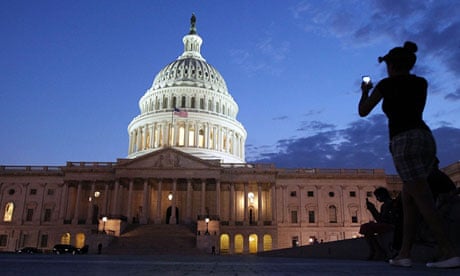Republicans' chance to win back the United States Senate in 2014 are up. Analysts from Nate Silver to Sean Trende put the chances at just south to about 50% for Republicans to take the six seats necessary to gain 51 seats. Why are Republicans doing so well?
The immediate answer is Democrats can't seem to find strong Democrats to run in states more Republican than the nation as a whole, as measured by the 2012 presidential vote. Democrats have yet to field any candidates in either Montana such as Brian Schweitzer or West Virginia, even though Democrats currently represent those states. Indeed, the majority candidates Democrats are finding to run in red states are lackluster. Even the better than average candidates such as incumbent Mary Landrieu of Louisiana are facing mediocre polling numbers.
Democrats' red state blues are a big deal considering Democrats have to defend seven seats more Republican than the nation as a whole, while Republicans only have to beat back a Democratic challenge in one state won by President Obama. Seven minus one equals the six seats the Republicans need for control.
Yet, I would argue that 2014 recruitment failures are as much about the current state of each party's coalitions than anything particular to this election cycle. There are now more states that lean Republican than lean Democratic. Twenty-six states are more Republican than the nation as a whole. Only 23 states are more Democratic. Virginia votes with the nation. Translating that to Senate seats, we'd expect something like a 53 to 47 Republican advantage on presidential vote alone.
Just twenty years ago, this Republican state edge might not have been so big of a deal. In 1993, 49% of the Senate Democratic caucus came from red states, and 28% of the Republican caucus came from blue states.
Now though, straight-ticket voting is becoming the rule for senate elections. Only 25% of the Democratic Senate caucus comes from red states, while 16% of Republicans come from blue states. The 25% and 16% listed above should fall even further as Republicans bump up their numbers with red staters in 2014, while the Democratic caucus will become more limited to blue staters.
These statistics explain why Democrats are having such recruitment problems in red states in 2014, and why they should for years going forward. People don't want to run in races they'll probably lose.
What demographics are behind the Republican state edge? Ironically, it's the same factor that many are citing as the possible reason for their demise in presidential elections: Republicans are increasingly the party of white and rural voters. Mitt Romney won white voters by 20pt, if you believe the exit polls. Romney took rural areas by 24pt. President Obama won non-whites by 62pt and took the largest cities by 40pt and moderate sized cities by 18pt.
The relationship between racial and geographic voting patterns is no accident. Only about 26% of the country as a whole live in the top 10 metropolitan areas. For minorities, those percentages climb significantly: 37% of blacks, who voted for Obama by a 10:1 ratio, live in the top ten metropolitan areas. This includes Washington, DC, which doesn't have any representation in Congress. Further, 45% of Latinos, who voted for Obama by greater than a 2.5:1 ratio, live in the top ten metropolitan areas.
That's why it should be no surprise that 36 of the 50 states in the union have a higher percentage of non-Hispanic whites than the nation as a whole. That puts the Democratic party behind the eight ball in winning more states than Republicans. If racial polarization in terms of voting patterns continue to exist or get worse, then it will only go downhill for Democrats in winning more states.
This isn't that big of a deal in winning presidential contests. The electoral college may be a lot of things, but it does take into account population in assigning electoral votes. Indeed, at this point, the Democrats seem to be enjoying an advantage in the electoral college. That is, they are in a better position to win the electoral college and lose the national vote than are Republicans.
On the Senate level, it is, however, a very big deal. Each state gets two senators, regardless of population. The deeply Republican and white smallest state Wyoming has a population of about 600,000 people. The deeply Democratic and diverse largest state California has a population of 38 million – 37.4 million people more than Wyoming.
But then why haven't Republicans already won the senate? Republicans have had recruitment problems of their own. Think of some of the Republicans put up over the past few years, including Todd Akin, Sharron Angle, Ken Buck, Richard Mourdock, and Christine O'Donnell.
If Republicans get some decent candidates like they have in North Dakota with Mike Rounds and West Virginia with Shelley Moore Capito this year, then the Senate should be a gold mine for them. Not only should Republicans have an easier shot at the majority, but they should have a better chance to run up the score in years in which they do well. Had Mitt Romney had won by the same percentage nationwide as President Obama did, he would have won 34 states compared to the 26 Obama took. That's eight Senate seats' worth.
Now, none of this means that Republicans will win back the Senate in 2014. Republicans need a slightly more favorable national environment than seen in 2012. Then, they still need candidates to take advantage of the math – candidates who don't make women run away when they speak.
What the math does mean, however, is that keeping all other things equal, the combination of the new Republican coalition and straight-ticket voting gives Republicans a big step-up in winning the Senate.
